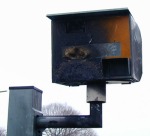 Recent implementations of surveillance systems have followed a predictable playbook.
Recent implementations of surveillance systems have followed a predictable playbook.
Politicians, government agencies, and corporations are pitting their collective agendas against us, and the rights of the individual are suffering.
Before heading up the Department of Homeland Security, then-Governor Janet Napolitano spearheaded the creation of a widespread surveillance system in Arizona. This article aims to show that while the names of the players change (Then DPS, now TSA; Then Redflex, Now RapiScan; etc), the game stays the same.
Creating the Problem
Then: As Governor, Napolitano urgently forces into place a statewide “photo enforcement” scheme on Arizona highways. A private contractor (Redflex) benefits and provides the surveillance equipment.
Now: As DHS Director, Napolitano rolls out “advanced imaging” scanners at airports nationwide while urging (threatening) other countries to follow suit. A private contractor (RapiScan) benefits and provides the surveillance equipment.
Mission Creep
Then: Redflex’s roadside ticketing cameras are found to record and transmit video 24 hours a day, despite denials by company lobbyists. Politicians feign outrage.
Now: RapiScan’s virtual strip machines are discovered to be capable of storing and transmitting images of travelers. Politicians feign outrage.
Alphabet Soup Agencies and Technological Snake Oil
Then: The Arizona Department of Public Safety (DPS) is charged with running the statewide surveillance network and vehemently defends its use. Phony statistics are used by the department to “prove” effectiveness, causing even supporting organizations such as AAA to question the official stats.
Now: Transportation Security Administration (TSA) agents utilize body scanners across the United States and agency officials vehemently defend their use, despite a Government Accountability Office (GAO) report which stated that such measures would not have stopped the so-called (attempted) “underwear bomber,” the exact incident which prompted the accelerated rollout of such scanners.
Unequal Protection Under the Law and Lacking Common Sense
Then: Under RedflexDPS’ automated ticketing and surveillance scheme, no two drivers are protected equally under the law. A driver with his true home address on file is much more likely to be served in-person with a ticket, while a ticket may not even be mailed if the vehicle is registered to a corporation.
Now: For the most part, TSA randomly selects who is to submit to a naked body scan, creating a clear standard of unequal protection. One can only hope that a true terrorist doesn’t slip through security because agents are too busy subjecting Grandma to “additional screening” for her carry-on pies.
Make it Clear Who’s Boss
Then: After outsourcing their responsibilities to Redflex, DPS created a unit to target and harass those who openly taunted their surveillance network. Detectives in the so-called “frequent flyer” division addressed the pressing threat of masked drivers and possible political opponents. When a horrible act of violence claimed the life of a photo radar company employee, DPS seized the opportunity to blame their opponents for being too “vocal.”
Now: TSA agents use the threat of “enhanced patdowns” —up and to the point of physical agent contact with travelers’ genitals (groping)— to prompt “compliance” with naked body scans. Those who “opt out” of naked body scans are publicly singled out, with widespread reports of TSA agents screaming “We have an Opt Out!” when confronted with a dissenter.
Conclusion
These parallel stories (ticketing cameras vs. naked body scanners) follow the same plot: The false promise of increased transportation safety via intrusive government surveillance.
Meanwhile, the inherent human right of freedom of movement is so severely crippled that obedient “compliance” is not only expected, but required.
Government regulations create a de facto monopoly over both roadways and airways regarding what hoops you will be required to jump through in order to proceed to your destination. Have the wrong papers or cross the wrong government agent, and you may find yourself detained, arrested, or even killed.
Welcome to the new United States: Land of the Fees, and Home of the Slaves.



 Posted by camscomingdown
Posted by camscomingdown 




 Andrew Noble, president of photo radar manufacturer Gatso USA, recently invoked 9/11 as a reason he believes the public is becoming more accepting to surveillance in the form of automated ticketing during an
Andrew Noble, president of photo radar manufacturer Gatso USA, recently invoked 9/11 as a reason he believes the public is becoming more accepting to surveillance in the form of automated ticketing during an 










